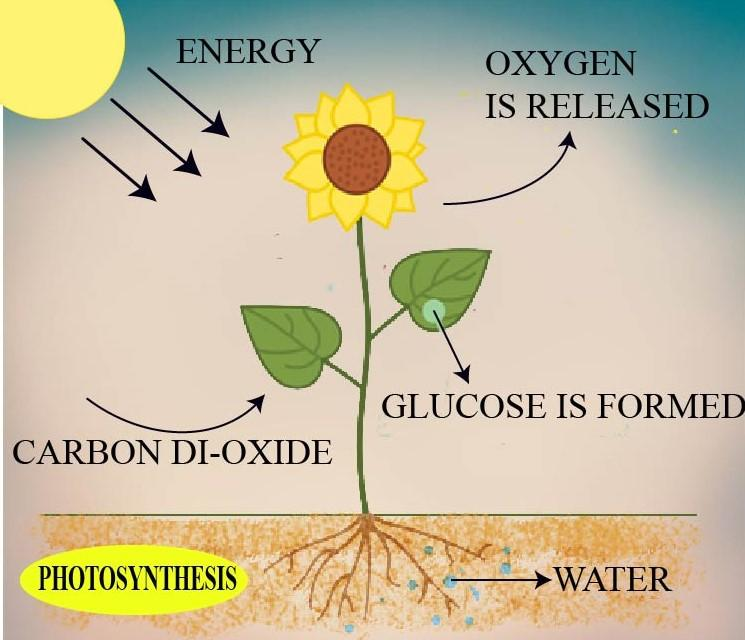
Does photosynthesis produce oxygen?
Answer
526.2k+ views
Hint: Photosynthesis is an anabolic process by which the chloroplast of green plants and other autotrophs synthesize carbohydrates (glucose). In this process, the water is oxidized while the carbon dioxide gas is reduced.
Complete answer:
-Photosynthesis is also known as carbon assimilation reaction as this is an oxidation-reduction process involving a light phase and dark phase reaction where water is oxidized and ${ CO }_{ 2 }$ is reduced to carbohydrates. Light-dependent reactions mainly occur due to the chlorophyll pigments present in the leaves that are the light-absorbing pigments.
The net reactions forming light reaction is $2{ H }_{ 2 }O\quad +\quad 2NAD{ P }^{ + }\quad +\quad 3ADP\quad +\quad 3{ P }_{ i }\quad \longrightarrow \quad { O }_{ 2 }\quad +\quad 2NADPH\quad +\quad 3ATP$
The leaves are made up of very small cells. Inside this cell, tiny structures are present called chloroplast. Each chloroplast contains a green chemical chlorophyll which gives leaves their green color. Chlorophyll absorbs solar energy. It is this energy that is used to split water molecules into hydrogen and oxygen then oxygen is released from the leaves into the atmosphere. Hydrogen and $C{ O }_{ 2 }$ are used to form glucose or food for plants.
Factors Affecting Photosynthesis-
The photosynthesis process requires several factors such as:
-Light Intensity: Higher light intensity results in a higher rate of photosynthesis. Whereas, low light intensity results in a lower rate of photosynthesis.
-Carbon Dioxide ${ CO }_{ 2 }$: To increase the rate of photosynthesis, a higher concentration of carbon dioxide is required. Usually, carbon dioxide found in the range of 300 – 400 PPM is found to be sufficient for photosynthesis.
-Temperature: It is important to have an ambient temperature range between 25° to 35° C for effective photosynthesis.
-Water: Water is the essential raw material for the process of photosynthesis whose deficiency may lead to various problems that may include less intake of carbon dioxide. Low water leads to the refusal of stomatal opening to retain the amount of water they have stored inside.
-Pollution: The pores of stomata get blocked then a large number of industrial pollutants and other particles get accumulated on the leaf surface. Thus blockage of leaf pores or stomata will result in less intake of carbon dioxide.

Note:
Chlorophyll is not the only photosynthetic pigment, but carotenoids, xanthophylls, anthocyanins are also photosynthetic pigments. Photosynthesis is the reverse of cellular respiration. The process of photosynthesis is not only performed by plants but also by other organisms. Colin Flannery in 1779 first introduced that the light is necessary for the process of photosynthesis.
Complete answer:
-Photosynthesis is also known as carbon assimilation reaction as this is an oxidation-reduction process involving a light phase and dark phase reaction where water is oxidized and ${ CO }_{ 2 }$ is reduced to carbohydrates. Light-dependent reactions mainly occur due to the chlorophyll pigments present in the leaves that are the light-absorbing pigments.
The net reactions forming light reaction is $2{ H }_{ 2 }O\quad +\quad 2NAD{ P }^{ + }\quad +\quad 3ADP\quad +\quad 3{ P }_{ i }\quad \longrightarrow \quad { O }_{ 2 }\quad +\quad 2NADPH\quad +\quad 3ATP$
The leaves are made up of very small cells. Inside this cell, tiny structures are present called chloroplast. Each chloroplast contains a green chemical chlorophyll which gives leaves their green color. Chlorophyll absorbs solar energy. It is this energy that is used to split water molecules into hydrogen and oxygen then oxygen is released from the leaves into the atmosphere. Hydrogen and $C{ O }_{ 2 }$ are used to form glucose or food for plants.
Factors Affecting Photosynthesis-
The photosynthesis process requires several factors such as:
-Light Intensity: Higher light intensity results in a higher rate of photosynthesis. Whereas, low light intensity results in a lower rate of photosynthesis.
-Carbon Dioxide ${ CO }_{ 2 }$: To increase the rate of photosynthesis, a higher concentration of carbon dioxide is required. Usually, carbon dioxide found in the range of 300 – 400 PPM is found to be sufficient for photosynthesis.
-Temperature: It is important to have an ambient temperature range between 25° to 35° C for effective photosynthesis.
-Water: Water is the essential raw material for the process of photosynthesis whose deficiency may lead to various problems that may include less intake of carbon dioxide. Low water leads to the refusal of stomatal opening to retain the amount of water they have stored inside.
-Pollution: The pores of stomata get blocked then a large number of industrial pollutants and other particles get accumulated on the leaf surface. Thus blockage of leaf pores or stomata will result in less intake of carbon dioxide.

Note:
Chlorophyll is not the only photosynthetic pigment, but carotenoids, xanthophylls, anthocyanins are also photosynthetic pigments. Photosynthesis is the reverse of cellular respiration. The process of photosynthesis is not only performed by plants but also by other organisms. Colin Flannery in 1779 first introduced that the light is necessary for the process of photosynthesis.
Recently Updated Pages
Why are manures considered better than fertilizers class 11 biology CBSE

Find the coordinates of the midpoint of the line segment class 11 maths CBSE

Distinguish between static friction limiting friction class 11 physics CBSE

The Chairman of the constituent Assembly was A Jawaharlal class 11 social science CBSE

The first National Commission on Labour NCL submitted class 11 social science CBSE

Number of all subshell of n + l 7 is A 4 B 5 C 6 D class 11 chemistry CBSE

Trending doubts
Differentiate between an exothermic and an endothermic class 11 chemistry CBSE

10 examples of friction in our daily life

One Metric ton is equal to kg A 10000 B 1000 C 100 class 11 physics CBSE

Difference Between Prokaryotic Cells and Eukaryotic Cells

1 Quintal is equal to a 110 kg b 10 kg c 100kg d 1000 class 11 physics CBSE

State the laws of reflection of light




